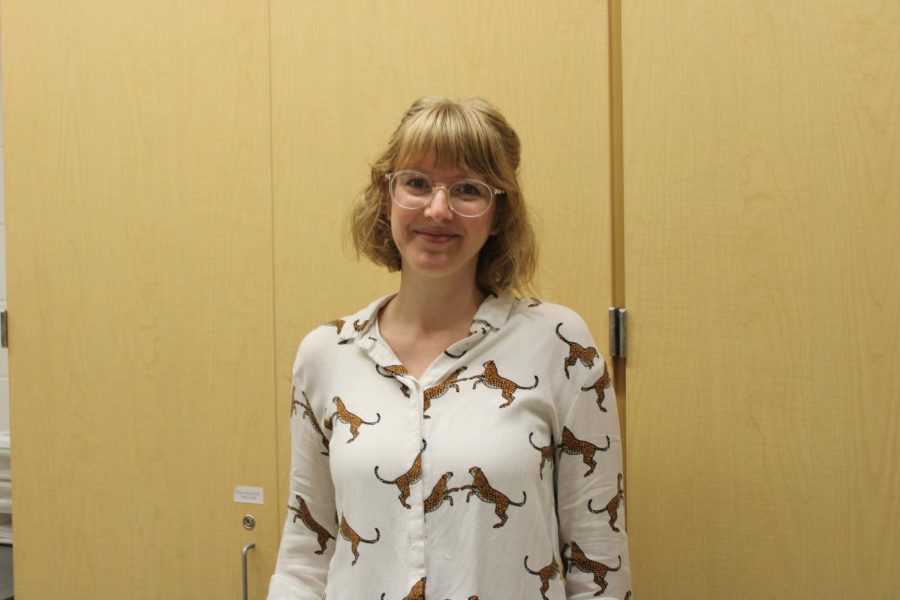Grace Stynes is creating a community in the art department with her abundance of artistic experience

More stories from Meghan Kennedy
Art teacher Grace Stynes posing for a picture in the infamous FHC art department
With a step into the ambient and expansively cozy art department, the vividly versatile art teacher, Grace Stynes, stands proudly in the artistic community she is cultivating at FHC.
Stynes has had a kinship to art ever since she was six years old and found her way into the field during college. Originally, she did not have the plan to pursue art on a higher, career-based level but landed on it while she worked in an art gallery.
“I loved art and I loved working with people,” Stynes said. “So after I worked in the gallery and was in the school, I kind of thought, ‘How can I put these together?’ and then I went back to school and got my teaching degree.”
Her sociable sensibilities have allowed her to interwork her skills variously into each type of class for many alternating age groups. As a result of her abiding artistic passions, she has developed into a guide for such age groups wanting to participate in the creation of art.
“I’m K-12 certified, and I’ve taught in elementary, middle school, and high school,” Stynes said. “I’ve also taught adults and I’ve taught babies, ranging from one to 70 [years old]. I have most of my experience in the K-12 world, and in the summers I get to teach [art] to lots of different age groups.”
Since each age group fluctuates with different motor skills and brain functionality, she can observe certain attributes and tendencies associated with her diverse range of students in relation to art class. And what ensues from the abundance of ages Stynes has interacted with is an omniscient perspective on how people connect with art and their creative abilities.
“I’m always surprised by every age group, that everyone is coming up with their own solutions, and it’s really lovely to see,” Stynes said. “I think there are a lot of differences between elementary and high school, just because you get to see them differently. I only saw elementary kids once a week, so it’s a lot harder to get into deeper ideas quickly, whereas in high school, I feel like we can kind of get through the basics and jump right into those more conceptual projects, which is what I really love.”
In terms of art in its purest form, Stynes knows her way around the block. Varying from ceramics to metals to large-scale oil paintings, she finds her footing within these specific artistic realms and mediums. But being tinged with open-mindedness, she does not have many qualms with other mediums.
Additionally, her impartiality to specific art forms has given way to her teaching the majority of art classes at FHC. While the other art teacher, Tyler Fewell, still advises the Digital Media classes, Stynes has preoccupied the AP Art, Drawing/Painting, and Ceramics classes.
“I can’t think of things that are within the art world that I wouldn’t want to teach,” Stynes said. “I think that there’s beauty in all the different mediums, and they’re all really special in their own way. But my favorite thing within that is pulling in more ideas. I feel like I’m always trying to layer the basic fundamentals but then adding in extra things on top.”
Aside from just wanting to guide people in honing their artistic skills, Stynes emphasizes the deep-rooted and imperative role art takes on in our society and within our beings. Art is not only a hobby or a class, but it conjoins a fundamental part of history, culture, and human expression. So through the impactful light she ingrains into the art department, Stynes embellishes her work and teachings with the utmost affirmation.
“Art is so much—it’s just one of those things that it is a part of the human experience,” Stynes said. “It’s been around for so long, and it’s there to help us communicate—it’s there to help us process. But it has also become so much more in our current culture because our society is so image-driven. Art has become this whole other language, right? I just think it’s so important for kids and students to have art because it teaches problem solving and self-esteem, and it records a history of who you are. It’s just there for all those little things. I think everyone should take art, even if you don’t think you’re an artist.”
For those who feel like they need an outlet, want to improve their skills, or just simply want to be immersed in the macrocosmic world of art, Stynes will be there to accommodate every art-related need. All it takes is a will, a dash of effort, and a couple of utensils.
“It’s good to do things that scare you,” Stynes said. “The only way to learn is to do it, so come to art. I’m not scary. I will teach you how to be an artist because honestly, I think that everyone’s an artist. When people say to me, ‘I’m not an artist,’ I’m like, ‘You are, you just don’t know yet’ or ‘It hasn’t come out yet.’ I get it, I felt that way too. I didn’t learn how to draw until I was in college, so it’s never too late [to start], and I’m never going to leave you hanging. I’m always going to help you.”

Meghan. also known as Meggie, is living up her senior year on The Central Trend. Starting out with a new role as Podcast Manager, Meggie is looking forward...



























































































